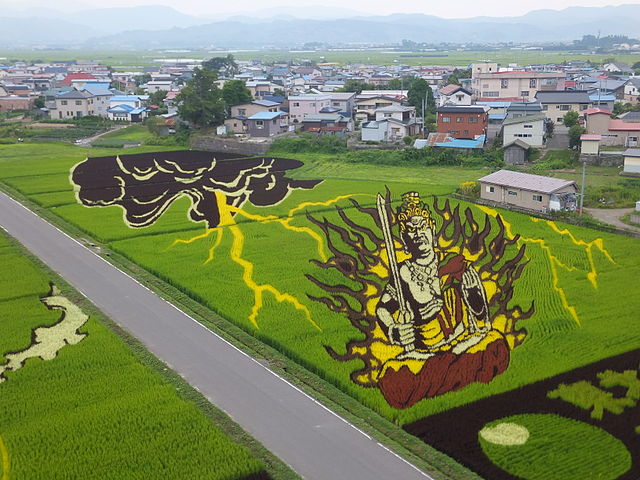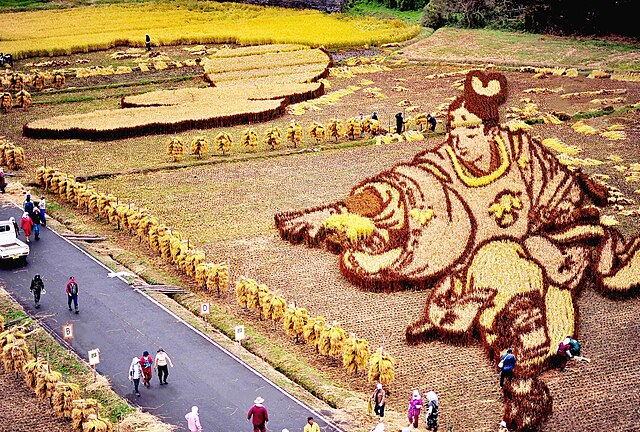Watch – Japanese Farmers Turn Rice Fields to Incredible Works of Art to Get People Interested in Farming Again!

In a small village in Japan, the summer sun rises over rice fields that hide a secret. From the roadside, they look ordinary, just rows of green stretching toward the horizon. But climb a nearby lookout and the fields reveal something impossible: giant portraits, sweeping landscapes, and intricate patterns woven entirely from living rice plants. How did farmers turn a staple crop into a gallery you can only see from the sky? And why did they choose art as their answer to a problem far bigger than the harvest?
The Village That Painted with Rice
Inakadate, a small farming village in the northern reaches of Aomori Prefecture, has always been known for one thing: rice. For centuries, its 8,000 residents tended the same fields in quiet rhythm with the seasons. But in the early 1990s, the village faced a challenge familiar to many rural communities in Japan. Young people were leaving, the population was shrinking, and the future of farming felt uncertain.
Then, in 1993, a town hall employee named Koichi Hanada and a handful of volunteers tried something unusual. They planted rice seedlings in carefully chosen colors, arranging them into a simple image of Mount Iwaki. It was more than an artistic experiment—it was an invitation for the community to see their land differently, and to remind outsiders that farming could still inspire wonder.
What began as a modest idea grew into a finely tuned annual tradition. With the help of computer-aided design, villagers learned to calculate perspective so precisely that massive, detailed murals emerged from the fields—portraits like the Mona Lisa, scenes of samurai, even the towering figure of Godzilla. By the mid-2000s, these summer artworks were drawing crowds in the hundreds of thousands. In 2006 alone, the Godzilla mural is believed to have attracted 340,000 visitors.
For a few short months each year, Inakadate transformed. The same fields that once produced rice in quiet anonymity became a seasonal stage for some of the most unique public art in the world. And with every mural, the village told the same story: farming has beauty worth traveling for.
Planting a Masterpiece
Turning a rice field into a work of art begins long before the first seedling touches the water. The process starts with careful preparation—leveling and measuring every section of the paddy so the design will line up perfectly when viewed from above. This groundwork is what allows the final image to reveal itself in stunning detail from the village’s observation towers.
By early June, the planting begins. Farmers, schoolchildren, and volunteers step into the mud together, following detailed maps that guide every row. Between seven and ten varieties of rice are chosen for their distinct leaf colors—deep greens, vibrant purples, and golden yellows—creating a living palette. Up close, the arrangement looks like a patchwork of colored blocks. From above, it becomes a vivid portrait of heroes, legendary creatures, or cherished symbols from Japanese culture.

Timing is everything. In mid-July, the colors are at their brightest, and by late August, the mural reaches its full glory before the harvest begins. Once the rice is gathered, the art disappears, living on only in photographs and memory until the next planting season.
Although computer mapping ensures the precision of every line and curve, the heart of the project is community. Each year, neighbors work side by side, turning what could be routine agricultural labor into a shared celebration of culture, creativity, and the land itself.
A Growing Canvas Across Japan
What began in one small Aomori village has quietly rippled across the country. Today, rice paddies from Kyoto to Kagawa are being planted with the same mix of artistry and precision, each region shaping the tradition into something uniquely its own.
In Yuasa, Kyoto Prefecture, the fields bloom into intricate, stencil-like patterns that mirror the land’s own beauty. Seasonal flowers, graceful wildlife, and delicate rural motifs emerge from the earth, as if the countryside were painting a self-portrait. In Shingu, Wakayama Prefecture, the designs reach deeper into history and spirituality. Murals here often honor Shinto traditions, depicting sacred symbols, mythic figures, and scenes tied to the revered Kumano Kodo pilgrimage route. Farther west in Kagawa, the tone is celebratory. Vast paddies burst with color to portray festivals, beloved landmarks, and scenes of community joy—drawing visitors as much for the energy as for the artistry.
@chotii.jp Demon Slayer Rice Field Art! This year’s Rice Field Art in Gyoda City is a collaboration with Demon Slayer. You can see it until mid‑October, and it’s most vibrant from mid‑July through the end of August. You can get there from Tokyo in 1.5 hours by train and bus. It’s a must-see this summer! 📹 Jul. 8, 2025 📍 Gyoda, Saitama🇯🇵 #鬼滅の刃 #鬼滅之刃 #demonslayer #japantrip #animelover #行田市 ♬ Gurenge – LiSA
This shared practice has grown into more than a seasonal attraction. It is a cultural movement, one that keeps agricultural traditions alive while inviting outsiders to see Japan’s rural heart up close. The art itself is entirely sustainable. Every design is grown from living rice plants, leaving no lasting footprint on the land. When harvest season comes, the images fade naturally, and the same rice that formed the mural is served on local tables.
In every village that joins the tradition, rice field art becomes a bridge—linking farmers to visitors, heritage to the present, and creativity to the land that sustains it.
Lessons Written in the Fields
Standing on a lookout over a rice paddy mural, you realize something—this is more than just art. It’s a reminder of how beauty is built. Every image begins months earlier, with a plan drawn to scale, hands in the soil, and the patience to wait for growth. In a world addicted to instant results, these fields whisper a different truth: the most lasting creations take time.

It’s also a story about what happens when people come together. Inakadate’s murals aren’t made by one artist working alone. They are planted by farmers, students, families, and volunteers moving in unison. Each seedling may seem insignificant on its own, but together they form something powerful enough to draw visitors from around the globe. The same is true for us—our small actions, when united with others, can shape something far bigger than we imagine.
And then there’s the relationship with the land. These murals don’t scar it, they honor it. At the end of the season, the art fades, the rice is harvested, and the fields are ready for the next chapter. It’s a cycle of creation and renewal that leaves the earth as healthy as it began. In a time when so much of the world takes more than it gives back, these villages have found a way to create beauty without compromise.
The rice field art is a postcard from rural Japan, yes. But it’s also a message to all of us: plant something meaningful today, nurture it with care, and trust that, in time, it will grow into something worth traveling the world to see.
Your Guide to Experiencing Japan’s Living Rice Canvases
Seeing Inakadate’s rice paddy art is more than checking a sight off your list—it’s stepping into a living tradition that combines creativity, culture, and community. If you want to experience it at its fullest, a little planning will go a long way.
@mirin723 #inakadate #ricepaddy #ricepaddyart #japan #fypシ #japantravelguide #青森 ♬ Seven (feat. Latto) – Clean Ver. – Jung Kook & Latto
- Time Your Visit for Maximum Impact
The murals reach their most vibrant colors between mid-July and mid-August. This is when the greens, purples, and golds are at their peak. An early June trip lets you watch the images slowly emerge, while arriving in late August risks seeing the fields just before harvest, when the designs begin to fade. - See It from Above
These murals are meant to be viewed as a whole, so head to the observation towers for the full effect. The Village Office Tower and the Yayoi no Sato Roadside Station Tower each offer a unique vantage point, and often showcase different designs for the same season. - Get Your Hands in the Mud
If you visit in late May or early June, join the community planting events. It’s a rare chance to help create the year’s artwork alongside farmers and locals. In autumn, some programs also welcome visitors to join the harvest, closing the loop from seed to rice bowl. - Plan Ahead for Travel
Inakadate can be reached via Hirosaki Station with local train or bus connections, but schedules are limited. Driving offers more flexibility, yet parking can be scarce on peak weekends. Arriving early not only avoids crowds but gives you more time to explore the village. - Respect the Fields and Support the Locals
These are working rice paddies, not just art installations. Stay on designated paths to protect the crops. Consider buying local rice, souvenirs, or handmade crafts from nearby markets—small purchases that directly support the farmers and artisans who keep the tradition alive.
Visiting Inakadate is not just about seeing something beautiful from a tower. It’s about stepping into a story that’s been planted, tended, and shared by a community proud of its roots. Leave with photos, yes, but also with the memory of a village that turned farming into a masterpiece.
Where Art and Harvest Become One
Inakadate’s rice fields are not just about spectacle. They are living proof that tradition can adapt without losing its soul, that a small village can capture the world’s attention without abandoning its roots, and that the same earth that feeds us can also inspire us. For a brief season each year, these fields show what happens when work becomes art, and art becomes a way of life.
Featured Image from 掬茶 under CC BY-SA 3.0
Loading...

